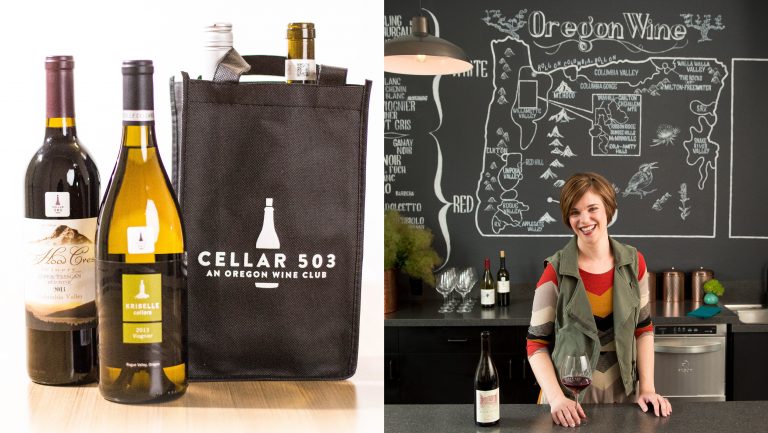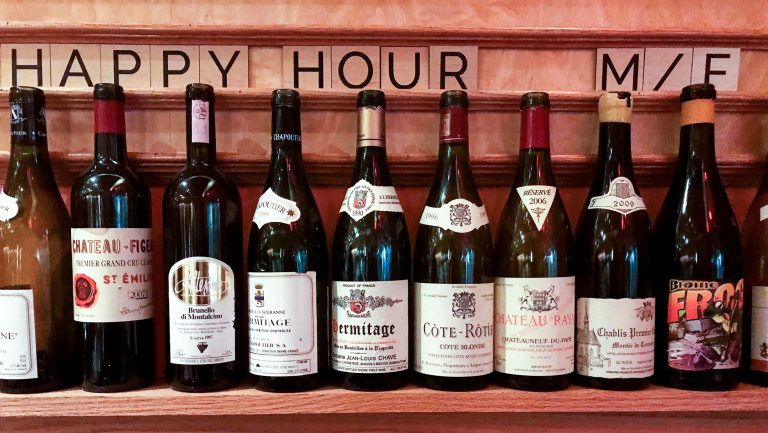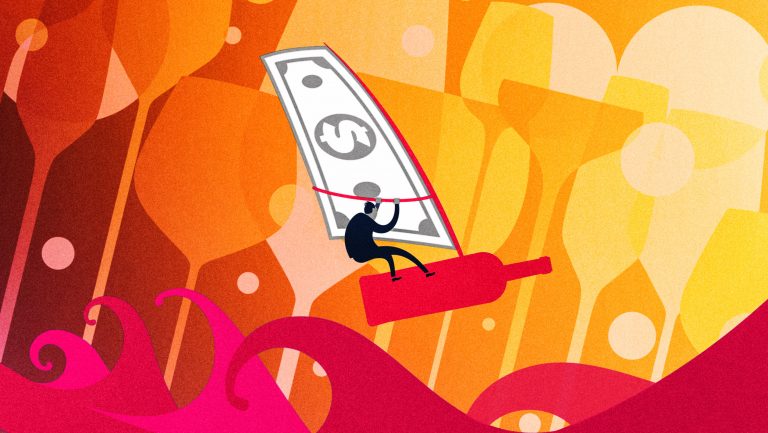Wine clubs are nothing new. They’ve been around since at least 1972, when the the Wine of the Month Club was founded. Even publications like the Wall Street Journal, the New York Times, and The Nation have wine clubs. But over the years, this sector of the wine industry has stagnated, according to Paul Mabray, a veteran of the successful wine tech startups Wine Direct and VinTank.
Until recently, that is.
A flurry of hyperfocused online wine clubs have launched over the past few years and appear to be thriving. There’s a wine club for organic and biodynamic wine. There’s one that focuses exclusively on Oregon producers and one that ships only Champagne; there’s even a club that singles out wines from women-owned wineries in Sonoma County. These subscription wine clubs are startups that are either self-financed or financed by investors (that is, they’re not financed by wineries).

Don’t miss the latest drinks industry news and insights. Sign up for our award-winning newsletters and get insider intel, resources, and trends delivered to your inbox every week.
“The subscription economy is in full force,” says Mabray, who is known in the wine industry as “the dean of digital.” “It’s a whole new rebirth of this thing that wineries have been doing for the longest time.” Though there are no statistics for subscription wine services (aka online wine clubs), Mabray, who is on the board of the startup Clubzz, a wine subscription management tool, says this sector is growing “very strongly.”
The rebirth of online wine clubs echoes the popularity of subscription services in general. Consumers are now buying personalized wardrobes on Stitch Fix, new razor blades on Harry’s Razors, and gourmet dinner ingredients on Blue Apron. Even Amazon has gotten in on the action with Subscribe & Save—customers get 15 percent off when they order the same staples on a regular basis. Consumers love the convenience, personalized service, and (in some cases) discounts. “And for companies,” says Mabray, “subscription services create a predictable revenue stream.” A recent survey by McKinsey & Company shows that the subscription economy has grown by more than 100 percent a year over the past five years, with the largest retailers generating more than $2.6 billion in subscription sales in 2016 (up from $57 million in 2011).
Etty Lewensztain launched Plonk Wine Merchants in 2010 as a highly selective online wine shop. “It was a digital version of that cool wine boutique in your neighborhood,” says Lewensztain. “I was getting rid of the wines that are a waste of time.”
But the unique wineries and offbeat grapes she featured on the site were so little known that customers were stumped. “They didn’t know the brand or recognize the varietal,” Lewensztain says. “So we decided to choose wine for people.” Sales with the wine club quickly outpaced à la carte purchases, and in 2013, Lewensztain rebranded Plonk as a wine club. (Though she’s added a wine store back onto the Plonk site, it’s mainly where current subscribers go to reorder wines they’ve loved from their shipments.)
Today Plonk Wine Merchants features wines that have been made with organic and biodynamic grapes—though Lewensztain stresses that she’s not dogmatic. “Some are certified; some are not,” she says. “We’re not religious about every single wine needing to be Demeter-certified.”
The same goes for natural wines. Though she’s generally a fan herself, she’s wary of selling the “interesting” but not mass-consumer-friendly type of natural wines. “You know—the kind that have particulate matter floating around in them,” she says. “I think those wines are better suited for an on-premise atmosphere where you can have a sommelier explain the wine to you—and take it back if you don’t like it.” But her litmus test is that the wines be made well and sustainably, with no sprays in the vineyard. “Authentic wines that are not made in a boardroom and tinkered with with Mega Purple and so on,” Lewensztain says. “We’re really not into that style of wine.”
Some recent popular bottles include the Balla Geza Fetească Neagră from Romania and a Pojer e Sandri Nosiola from Italy’s Trentino region. Plonk’s monthly shipments of 4 or 12 bottles include shipping costs. The 4-bottle shipment is $110, and 12-bottle is $285, making it the better deal, at $23.75 a bottle. Plonk features wines only from existing wineries (there are no private-label wines). Though Lewensztain would not disclose how many members Plonk has, she said the business has grown “quite a significant amount” over the past five years. Like other online wine clubs included in this article, Plonk does not accept marketing dollars from wineries. “We are self-funded,” says Lewensztain, “and we definitely don’t take any sort of payment.”
Plonk Wine Merchants provided inspiration for Carrie Wynkoop, a political strategist based in Portland, Oregon, who founded the wine club Cellar 503 three years ago. Says Wynkoop, “Lewensztain does a good job of explaining wines in a non-snobby way.”
But Wynkoop created Cellar 503 mostly because it was something she craved. “I have a big passion for Oregon and for Oregon wine,” she says. “I was sitting on the beach with my husband, and I was like, ‘I just want someone to send me Oregon wine to my doorstep.’ He said, ‘There you go: That’s your idea.’” Six months later, she had launched Cellar 503, focusing on small-batch winemakers (fewer than than 10,000 cases a year) and bottles under $30. The club, which Wynkoop and her husband funded through their own savings, is breaking even right now, with roughly 300 club members, but Wynkoop says they’re on track to make a profit in 2018. Though 40 percent of Cellar 503’s members are from Oregon, the remaining 60 percent hail from 28 other states—an indication of Oregon wine’s prominence on the national stage.
Wynkoop loves ferreting out small producers that the wine-drinking public would otherwise not know about, saying, “I like to call myself a little PR agency for the small guys.”
Each month, to keep things fun, Wynkoop sets a theme. January was “Italy in Oregon,” so she featured wines like a 2014 Primitivo from Cana’s Feast and a 2016 Vermentino from Troon Vineyard. February—“We Love Southern Oregon!”—included bottles from little-known wineries like Simple Machine in Talent (near Ashland) and Nicole Reese in Medford. In May, to celebrate Mother’s Day, Wynkoop features women winemakers. Members can choose to receive shipments of two or four bottles, either monthly or quarterly.

After experimenting with prices, Wynkoop now has a flat pricing structure. “One of the things members said was irritating was that [the price] was different every month,” Wynkoop says. So now, two bottles of white are always $45, and two bottles of red are always $55; mixed is $50. (Shipping is an additional $19.99, though club members in the Portland area can pick up their wines at a monthly free tasting at the Cellar 503 tasting room.) Because Wynkoop wants to feature wines that are approachable and affordable, bottle prices never exceed $30. “I want folks to feel comfortable opening them on a Wednesday night,” she says, “[and] not feel they need to save them for a special occasion.”
But there is a wine club at the “special occasion” end of the spectrum too. SommSelect, founded by Master Sommelier Ian Cauble in 2014, focuses on premium wines—the kind of high-quality bottles you’d find at Michelin-starred restaurants. “There are a lot of people in this space who are discounting,” Cauble says. “[But] nothing incredible is ever 80 percent off.”
That said, for premium wines, SommSelect’s half-case prices are hard to beat. The club offers a monthly “educational blind-tasting kit” of six wines (three red, three white) for $199, or Somm Six, also $199, a monthly shipment of six of Cauble’s favorite wines (a mix of reds, whites, and rosés). Shipping is included.
But most of the company’s business comes from à la carte ordering. Every day, SommSelect sends out one to two detailed emails telling the story of a wine—profiling its winemaker, the estate’s history, and its appellation. David Lynch, the James Beard Award–winning wine writer and former wine director at Babbo, Quince, and more recently, St. Vincent, was hired as SommSelect’s editorial director last year, and he and other writers help Cauble compose the lively, absorbing profiles. (Cauble’s deep tasting notes are included, as are food-pairing recommendations.) Customers can either snap up the featured bottle on the spot or build a custom order for later shipment. (Members get free shipping if they buy roughly $100 worth of wine.) The custom order ships after 60 days or once it has reached a 12-bottle case—whichever comes first.
“We’re offering wines that people are fighting to get a taste of,” says Cauble, noting that when allocations are small, the emails go out only to the company’s top 500 customers. Some examples of upcoming wines that will be offered to all email subscribers are Nicolas Joly’s Clos de la Bergeries Savennières 2014, for $55, and a 1990 Frog’s Leap Merlot, for $150.
Cauble would not divulge the number of club members SommSelect has on a monthly basis, but 20,000 people have signed up to receive the free daily emails. He says business has been growing by 20 to 30 percent per year since 2014. “We are making money,” Cauble says, “but everything is going back into the company.” SommSelect has new offices in Sonoma, California, and is expanding its warehouse as well.
Last fall, after the wildfires in Northern California, the writer and brand strategist Amy Bess Cook posted a list of women-owned wineries in Sonoma County. “I wanted to bring attention to female wine entrepreneurs,” she says. “There are plenty of women in the wine business, but we’re not in departments of upper management.” Cook’s intent was to create awareness so that consumers could funnel their dollars to these women-owned businesses. After getting positive feedback on the site, Cook, who had operated a wine club at Tin Barn Vineyards, decided to start Women-Owned Wineries, a club dedicated to these wines. It launched a few weeks ago, financed so far through a crowdfunding campaign. The club’s current focus is on the 51 wineries on the WOW Sonoma site initially, but Cook says that it will eventually grow to include all women-owned wineries in the U.S. Bottles will start shipping in May.
Niche wine clubs like these illustrate the continuing fragmentation of the wine market, says industry analyst Rob McMillan, the founder of Silicon Valley Bank’s Wine Division and the author of the annual State of the Wine Industry report. But they may prove to be exactly what the discerning consumer desires. “The need is there to get these small wines to consumers,” McMillan says. “The wine lovers that are out there want these. If you can be a trusted curator, that has value to consumers.”

Dispatch
Sign up for our award-winning newsletter
Don’t miss the latest drinks industry news and insights—delivered to your inbox every week.
Hannah Wallace writes about food, wine, sustainable agriculture, health, and travel for CivilEats.com, Inc., Food & Wine, Vogue, Portland Monthly, and the New York Times.







